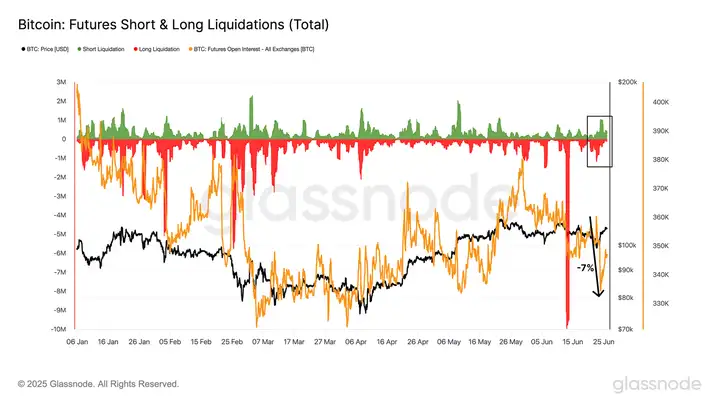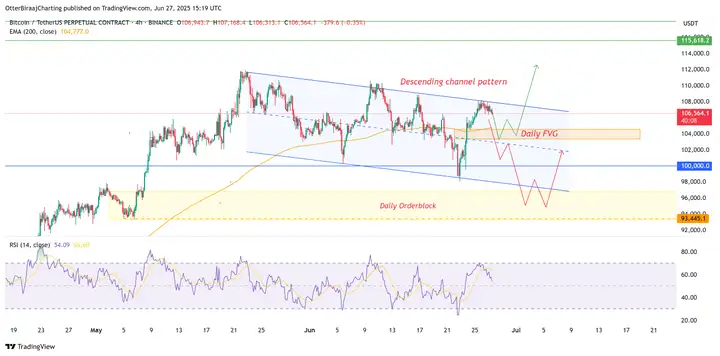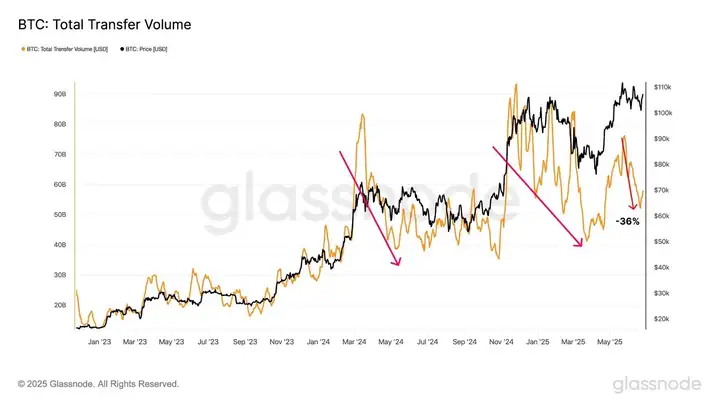Bitcoin experienced strong volatility at the beginning of the week, as the intense fluctuations from last weekend to Monday triggered a massive clearing in the derivatives market.
According to glassnode, within just 24 hours, $28.6 million in long positions and $25.2 million in short positions were liquidated, reflecting a rare two-way clearing. This caught leveraged traders off guard and indicated a rapid shift in market sentiment.
VX:TZ7971

The outstanding BTC contracts dropped by about 7%, from 360,000 BTC to 334,000 BTC. This significant decline suggests that speculative leverage is being temporarily cleared, indicating the market may be in a "reset" phase.
Although Bitcoin's price remains in the $100,000 to $110,000 range, BTC's on-chain activity is showing signs of cooling. Profitability indicators are weakening, and user engagement remains low, suggesting the market may be entering a consolidation phase.
The market appears to be digesting recent gains and waiting for a new wave of demand to drive the next rebound.
From a technical perspective, Bitcoin failed to clear external liquidity near $109,000, leading to a bearish tendency on the 4-hour chart. The current price trend remains confined within a downward channel, with a key focus area between $103,400 and $104,600.
This area coincides with the fair value gap (FVG) on the daily chart and is supported by the 200-day exponential moving average (EMA), increasing the possibility of a short-term rebound.

Given BTC's potential to attract liquidity in the current price range, the possibility of breaking through the downward channel and setting new highs still exists. However, the overall market structure may remain in a consolidation state until bullish momentum returns and on-chain activity recovers.
Core Inflation Rises, Bitcoin Faces Pressure
The lack of further upward momentum may mean the downward trend will continue next week. Despite recent optimism about potential Federal Reserve rate cuts, the latest inflation data suggests the Fed has little reason to change its stance.
The Fed's preferred inflation metric, the Personal Consumption Expenditures (PCE) index, rose to 2.3%, in line with expectations; the core PCE index rose to 2.7%, slightly higher than the predicted 2.6%. This is the first increase since February 2025, reflecting a resurgence of inflationary pressure.
As there are no signs of consumer price increases weakening, the Federal Reserve may maintain current rates and keep financial conditions tight - which is not particularly favorable for risk assets like Bitcoin.
glassnode's data also reinforces this cautious view, as second-quarter spot trading volume only slightly increased to $7.7 billion. Previously, transfer volumes in the early part of this quarter dropped by 36%, indicating a clear reduction in speculative sentiment.

However, US stocks have reached new highs, and we'll see if they continue to surge on Monday, potentially pushing BTC above $110,000. If the price breaks through the consolidation range, combined with continued strong inflows into the Bitcoin spot ETF, the market may welcome a new bullish trend.







